Key highlights
- Understand the difference between domain and website ownership and why it matters for legal or contact purposes.
- Uncover multiple ways to find domain owner using domain registration history, WHOIS lookup and online tools.
- Learn how to navigate privacy-protected domains and what to do when ownership details are hidden.
- Explore how platforms like LinkedIn, Hunter.io and website footers can provide valuable contact information.
- Discover the steps to take if you want to purchase a domain name and why it’s smart to have backup domain name options.
Domain registration is the first step in creating a website, where your information gets recorded in the official domain registry for a specified period. Once a domain is registered, the registration data is added to the WHOIS database, which stores ownership and contact details.
So, how do you use this information to find out who owns a domain in Canada?
Here’s a quick overview of the most effective methods:
- WHOIS Lookup: Use CIRA WHOIS or ICANN WHOIS to check registrant info.
- LinkedIn Search: Filter company staff by roles like Webmaster or IT Lead to identify responsible admins.
- Domain Broker Help: Hire a broker to negotiate or contact the owner if privacy tools block direct outreach.
Keep reading to learn the difference between domain and website owners and steps to find the owner of domain name. We’ll also explore the WHOIS record and domain’s history.
Why might you want to find the owner of website?
Purchasing a domain name is one of the most common reasons to find domain owner. Let’s say you’re launching a business website. To check domain availability, use the Bluehost domain search tool. But you discover that your desired domain name is already taken.
In such cases, you can contact domain owners to ask if they’re open to selling the domain. This often happens through direct outreach or domain auctions, depending on the domain registrar.
You can also verify the current owner’s information for different reasons. For example, you may have questions about the site’s content or design. Some people also contact owners to report technical issues or suspicious activities.
Whatever the reason, this guide will show you how to use tools like WHOIS lookup services and WHOIS domain lookup platforms to get the details you need. It includes contact information, domain expiration date and ownership records.
Are domain owner and website owner the same?
In many cases, the domain owner and website owner are the same; however, this is not always the case. So, how do you know who truly owns a domain name?
Let’s take a business example. A Canada-based company may operate a website under a corporate brand. However, the domain can be registered under a marketing manager, IT lead or third-party developer.
When a domain is registered, the WHOIS database typically includes several types of contact information: Registrant, Admin, Technical and Billing. Of these, the registrant is considered the legal owner in the WHOIS database.
But if your site was built by an agency, the domain registrar account may still be under their control. If your personal details don’t appear as the registrant, you technically don’t own the domain, even if you paid for it.
In some cases, a domain privacy service may be in place, masking the real owner’s identity through privacy protection services. These services help registered users maintain anonymity, but they also make ownership less transparent.
Fortunately, a WHOIS domain lookup or WHOIS search can still help you find domain owner, even if only partial WHOIS data is available.
How to find the owner of a website?
There are several ways to find owner of domain, even if it’s protected. From scanning the website for clues to using WHOIS data and email lookup tools, these methods can help you identify or contact the site owner.
Here are five proven of how to find the owner of domain:
- Search the website for contact clues
- Look at domain registration history from the WHOIS lookup tool
- Check with a domain broker
- Use search engines and social media to find domain owner
- Find an email associated with the domain name
Not sure where to start? Use the table below for a quick overview of each method—what it’s best for, what kind of data it reveals and how to apply it.
Quick comparison: Ways to find domain owner in Canada
| Method | Best for | Data access | Cost | Tip |
| WHOIS Lookup | Most domains | Registrant name, email, DNS, expiry date | Free | Use CIRA WHOIS for .CA domains |
| Website clues | Active websites | Email, business name, dev credits | Free | Look for privacy policy (PIPEDA requires contact details) |
| Domain broker | Premium/inactive domains | Direct or third-party outreach | Paid (varies) | Choose a broker familiar with CIRA rules |
| Social media & LinkedIn | Company-owned domains | Owner, IT/Admin staff | Free | Filter by “Webmaster” or “IT Lead” on LinkedIn |
| Email lookup tools | Business domains | Email addresses, admin roles | Free to paid | Use tools like Hunter.io to validate .CA domain contacts |
Now that you have a quick snapshot, let’s walk through each method step-by-step with examples and tools to guide you.
1. Search the website for contact clues
If you’re wondering how to find owner of domain name, start with the site itself. A company’s website can often reveal ownership or contact details, especially if the domain is linked to a business.
If the domain has been registered but there is no active site yet, skip ahead to the WHOIS lookup tool or domain registration check. But if there’s a live site, try these key locations:
- Contact Us page
- About page
- Website footer
- Privacy Policy
Many registered websites include mailing addresses, email addresses, or even telephone numbers to stay compliant with privacy laws. Business or portfolio websites may also feature the nameserver information or mention the development team.
If no contact information appears on the usual pages, scroll to the footer. Look for copyright credits or developer links. These small elements can lead to the current owner or the agency managing the site.
Don’t forget to check the privacy policy. In Canada, privacy regulations, such as PIPEDA, require websites that collect data to disclose a contact method for addressing privacy concerns. They often list a mailing address, email address or telephone number.
Even if domain privacy tools hide the WHOIS ownership information, this page can still connect you with someone responsible for the domain or site.
2. Look at domain registration history from WHOIS lookup tool
Running a domain availability check, whether through a WordPress search or an instant WHOIS domain lookup, can indicate if a domain name is available. But it won’t identify the current owner.
To access ownership information, you need to search the WHOIS database. This collection stores WHOIS data and historical WHOIS records for every registered domain. It includes changes in ownership and contact details.
Think of it as a digital library checkout system. Each domain is tracked in a centralised registry, which logs changes in ownership, renewals and contact updates over time.
The Internet Corporation for Assigned Names and Numbers (ICANN) oversees all domain registrars and requires them to share WHOIS information as part of the registration process.
In Canada, this responsibility is managed by the Canadian Internet Registration Authority (CIRA). It regulates .CA domain registrations and maintains a separate WHOIS database for Canadian domains.
To perform a WHOIS lookup, follow these steps:
- Visit https://whois.icann.org.
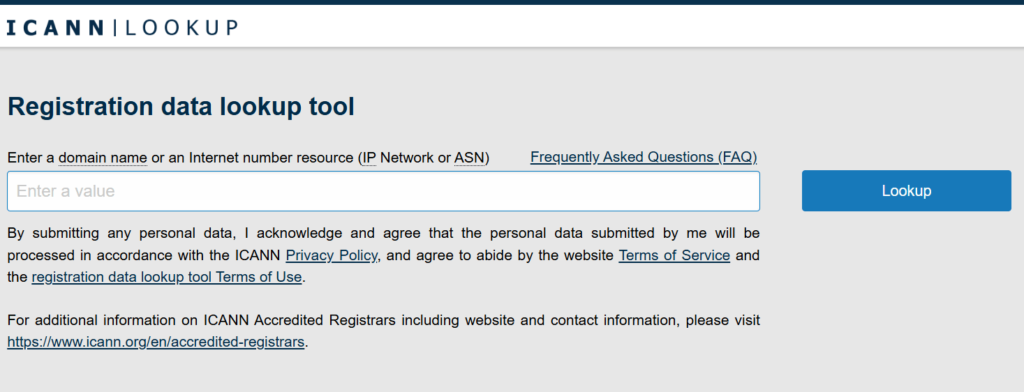
- Enter the domain name.
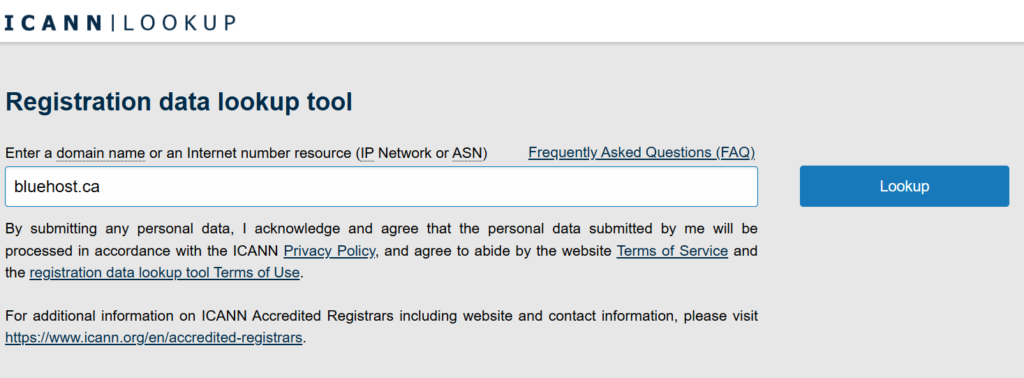
- Click the ‘Lookup’ button, and it’ll show you domain and contact information.
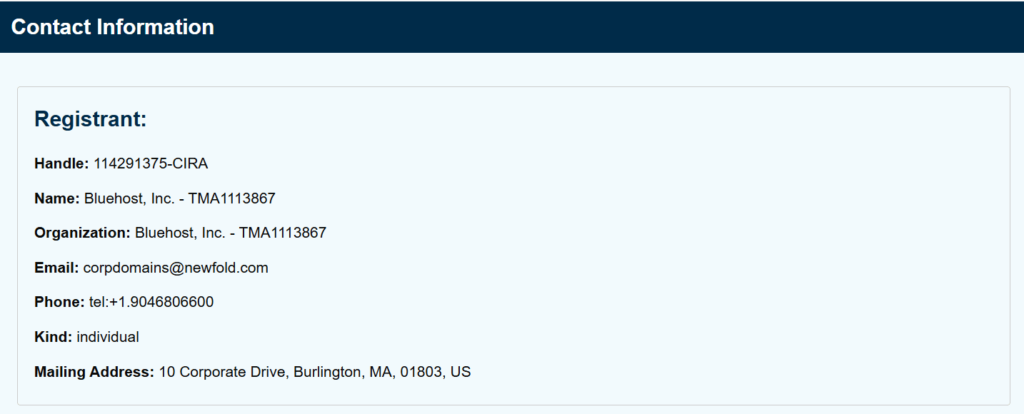
If the domain is registered, you’ll find available contact info. For example, mailing address, telephone number, (DNS) nameserver information IP address of the domain’s hosting server or technical admin contact. It depends on what is publicly listed in the WHOIS record.
What if domain privacy service is enabled?
Some domain registrars offer a privacy service or complete domain privacy. In these cases, the WHOIS domain listing will display generic privacy protection services instead of the actual personal details of the owner.
While this protects sensitive data, it also means you may need to rely on expiration dates. You can use a WHOIS domain lookup again later if the domain becomes inactive.
You can also monitor domain auctions or set alerts with a domain registry service. They’ll notify you when your desired domain becomes available.
3. Check with a domain broker
If a WHOIS lookup or WHOIS domain lookup doesn’t return helpful WHOIS data, another option is to contact a professional domain broker. These experts help facilitate the purchase of a desired domain name or assist with selling a domain through direct outreach or domain auctions.
Some brokers work directly with businesses or individuals and can reach out to the current owner on your behalf. They typically have access to private WHOIS information or established connections with major registrars.
Note: Brokers charge a fee for these services, and success isn’t guaranteed. It’s best to work with a domain broker only if you’re committed to purchasing the domain name in question.
Before proceeding, research reputable brokers to ensure they adhere to Canadian privacy laws and industry standards. If the perfect domain is unavailable, consider alternate options or monitor available domains using alert tools or backorder services.
4. Use search engines and social media to find domain owner
If a WHOIS domain lookup or WHOIS search doesn’t lead to useful contact information, try turning to search engines and social media. This type of digital investigation can be particularly helpful if a business or organisation owns the domain and has staff managing its website.
Look for employees in departments like IT, Web, Marketing or Network Administrators. These individuals are typically responsible for domain setup and technical issues.
Use LinkedIn to your advantage:
- Visit the company’s LinkedIn page.
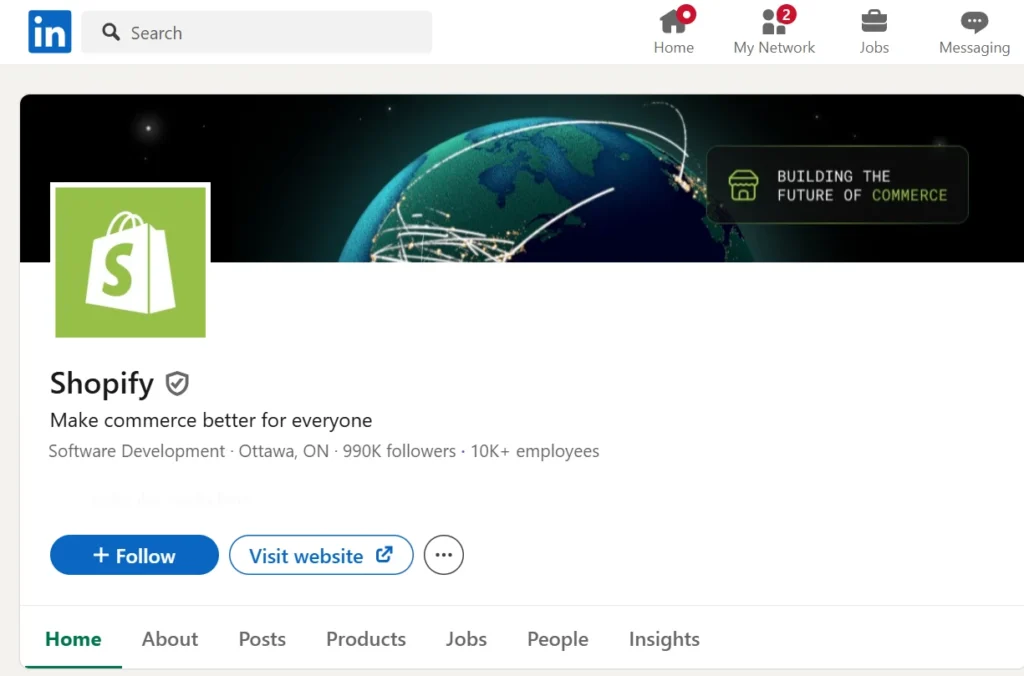
- Click on the number of employees.
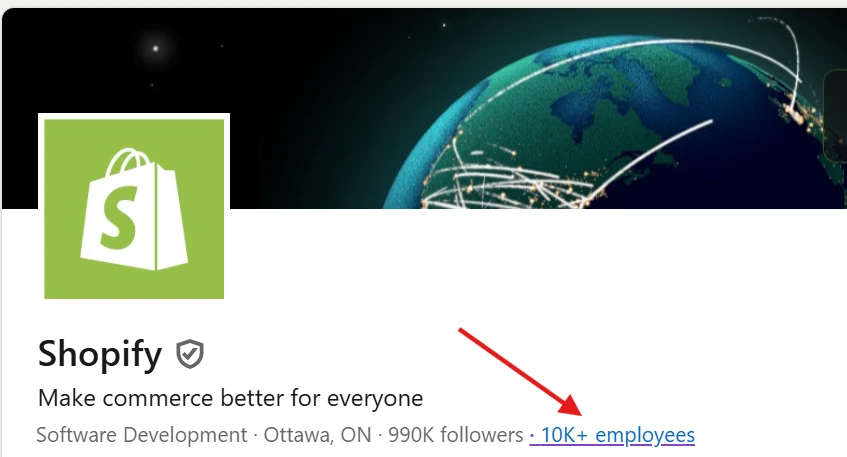
- Use the ‘All Filters’ button on the search results page.
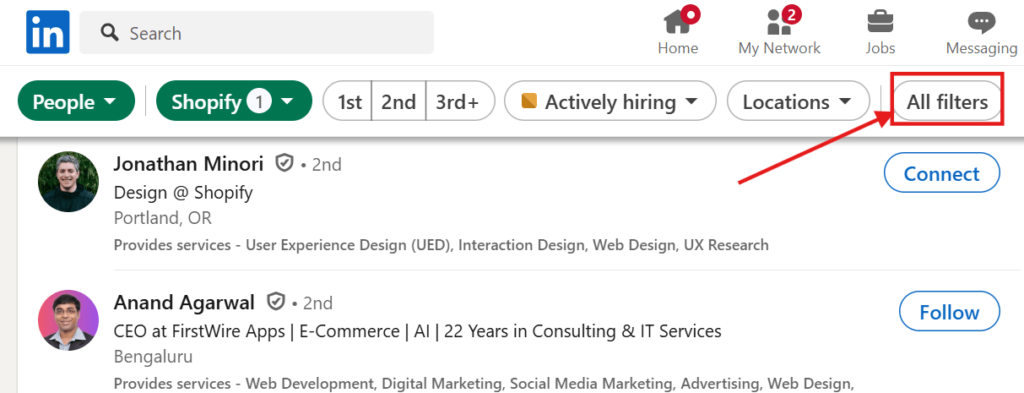
- Under ‘Title’, enter terms like ‘Webmaster’, ‘Administrator’ or ‘IT Lead’ and click on ‘Show results’.
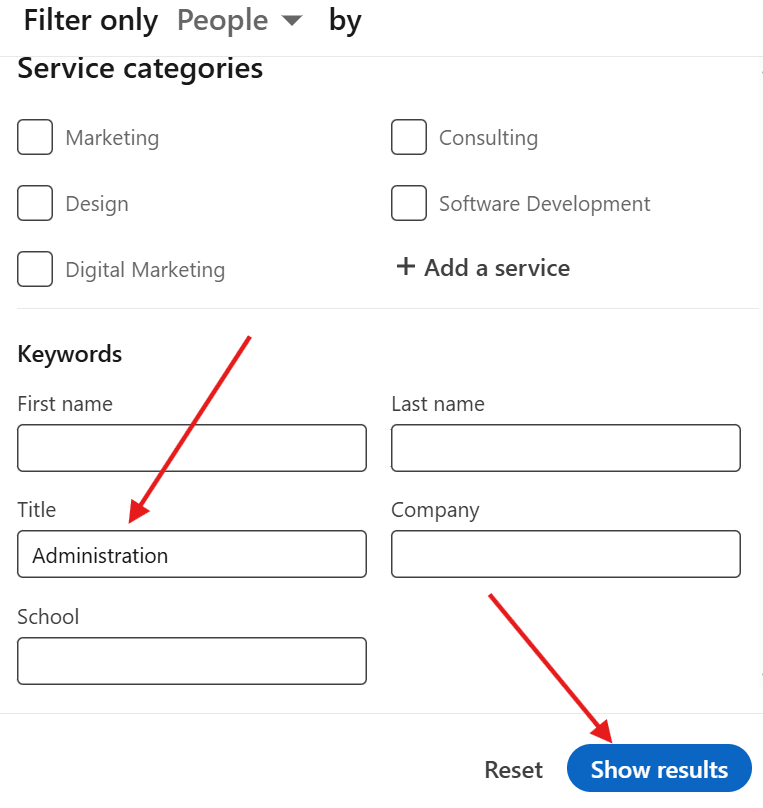
You can also cross-reference their email address, mailing address or telephone number via a lookup tool like Hunter.io or Voila Norbert to validate the details.
While this method may require some patience and creativity, it’s often effective in identifying a current owner or someone who can connect you to them.
5. Find an email associated with the domain name
If WHOIS data or social media hasn’t revealed the domain owner, you can try locating an email address linked to the domain name itself.
When a domain is registered, the owner can create email addresses using that web address, for example, info@[bluehost].ca. Tools like Hunter.io help you uncover these contacts by performing an automated WHOIS domain or email-based lookup.
Here’s how it works:
- Enter the domain name into the lookup tool.

- The system scans public sources to find related emails.
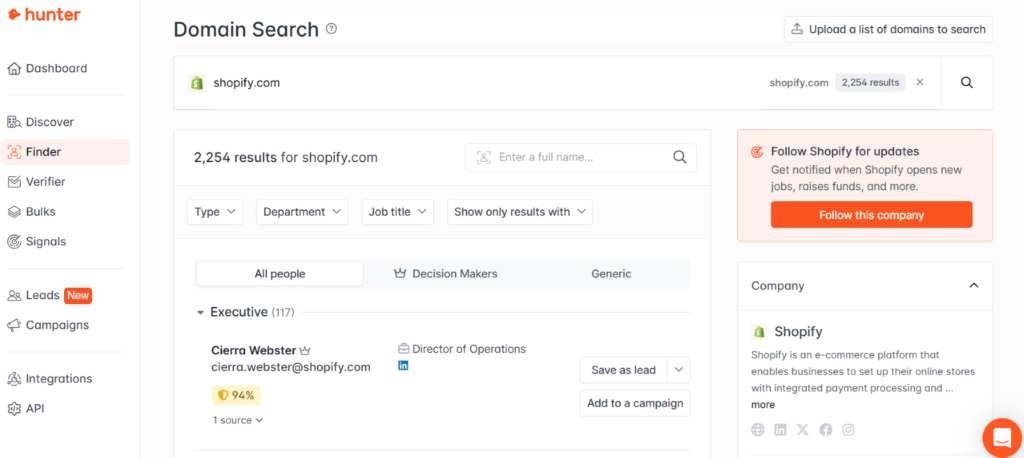
Note: It validates the email address by checking for bounce-backs.
Under CIRA’s rules, all .CA domain transfers require registrant confirmation via email. The buyer and seller must verify the transfer request before the domain can be officially reassigned.
Tools like Hunter.io are particularly useful for business domains. They can often reveal a mailing address, telephone number or admin contact if listed publicly.
These tools don’t always guarantee results, especially if privacy protection services are enabled. However, they still offer a helpful workaround for contacting domain owners or verifying the current owner’s status.
If your desired domain is linked to an inactive or outdated address, set a reminder to revisit the WHOIS lookup tool or monitor it using alerts. You might catch it before the expiration date or find it again through available domain listings.
Save 90% with Bluehost eCommerce Premium bundle. Launch your site fast with a free .CA domain, Yoast SEO, YITH plugins & powerful WooCommerce tools—no coding needed.
How to buy a taken domain in Canada (step-by-step)
If your desired domain name is already registered, don’t lose hope. Many domain owners are open to selling, and there are legitimate ways to initiate a purchase request.
Here’s a step-by-step guide to buying a taken .CA domain in Canada:
Step 1: Search the domain using WHOIS or CIRA lookup
Use CIRA WHOIS to check if the domain is registered and whether ownership or contact details are visible.
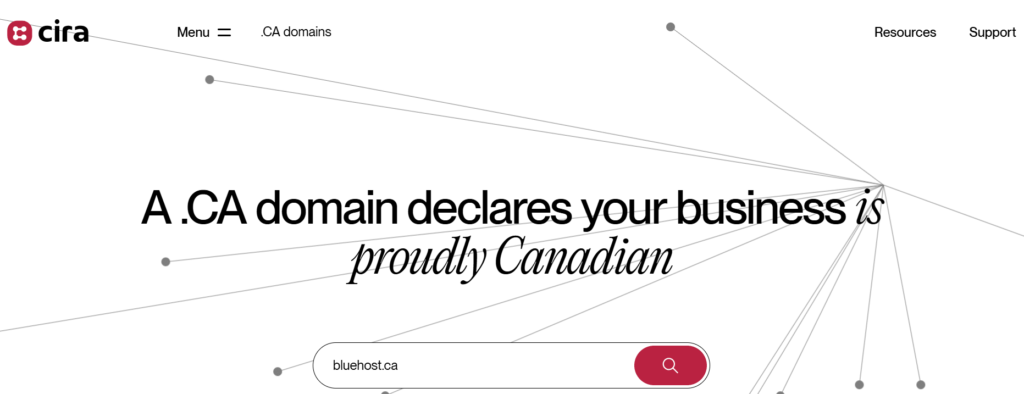
Tip: The CIRA WHOIS tool is also available in French. Click “Français” at the top of the page if you prefer using the tool in French.
Step 2: Reach out to the current domain owner
If WHOIS shows a contact or admin email, send a polite inquiry stating your interest in purchasing the domain. Avoid sounding overly eager and keep it professional.
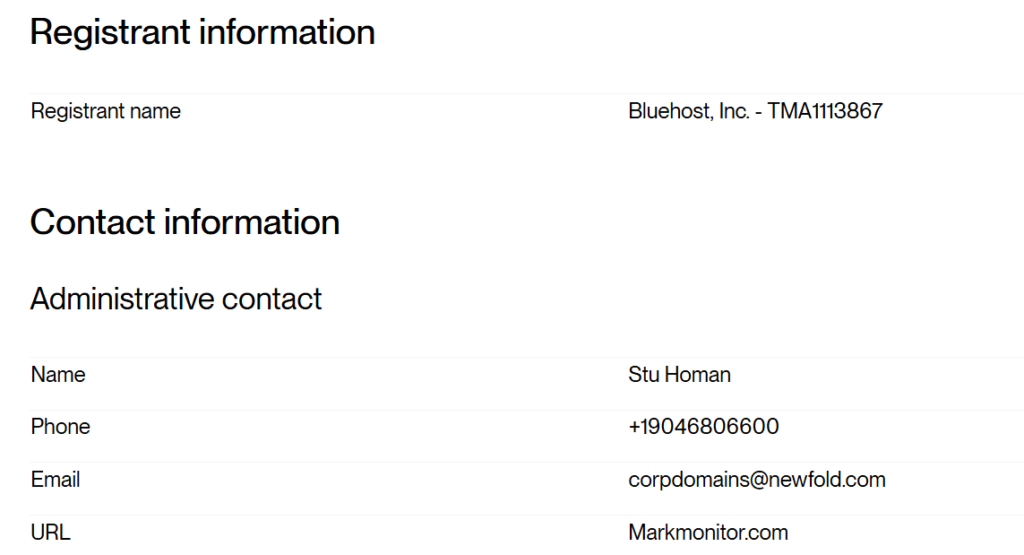
Step 3: Use a domain broker if contact fails
If the owner’s details are masked or outdated, consider hiring a domain broker who can negotiate on your behalf. Make sure they are familiar with CIRA’s domain transfer rules.
Step 4: Agree on the price and terms
Once the owner responds, agree on a fair price. Use secure platforms like Escrow.com for the transaction to ensure safety for both sides.
Step 5: Transfer ownership following CIRA policies
In Canada, .CA domains must follow specific CIRA transfer protocols. Both parties will receive a transfer confirmation email, and ownership updates must be verified.
Tip: If the domain isn’t for sale, consider a similar domain with a different TLD or variation, and monitor the original name using domain alert tools.
WHOIS Privacy vs GDPR vs PIPEDA: What’s the difference?
When trying to uncover domain owner information, you may come across hidden or redacted details. This happens because of privacy laws and services protecting user data.
Let’s break down how WHOIS Privacy, GDPR and PIPEDA differ when it comes to visibility, scope and penalties:
| Aspect | WHOIS Privacy | GDPR | PIPEDA |
| Applies to | Domain registrants | EU residents | Canadians |
| Scope | WHOIS contact info | All personal data | Business-held data |
| Default enabled? | Optional | Yes (by default) | Case-based |
| Visibility | Hidden via proxy | Redacted | Limited |
| Penalty risk | None | High fines (€) | $10 CAD fine (CIRA) |
Let’s explore what each framework means in more detail:
1. WHOIS Privacy protection
This is an optional service provided by domain registrars. It replaces the registrant’s name and contact info with a proxy service, helping users stay anonymous.
2. GDPR (General Data Protection Regulation)
Applies to EU residents and protects personal data, including WHOIS data. Many registrars have defaulted to redacting personal details from public WHOIS listings to remain compliant.
3. PIPEDA (Personal Information Protection and Electronic Documents Act)
Canada’s equivalent to GDPR. PIPEDA protects how businesses handle personal data, including domain registrant info. It allows individuals to request corrections or removal of outdated WHOIS details.
Did you know? Under CIRA’s .CA domain rules, providing inaccurate WHOIS data may result in a $10 CAD fine or suspension of the domain.
Final thoughts
Whether you want to make an offer on a desired domain name or simply connect with the person managing a site, there are multiple ways to find the domain owner — even when privacy tools are in place.
From using a WHOIS lookup tool, checking the WHOIS database, reviewing the WHOIS database or trying a WHOIS search, each method gives you access to valuable registration and contact details.
While privacy services like domain privacy protection services can sometimes hide the real owner, persistence pays off. You may uncover a mailing address, telephone number or admin contact that leads to the right person.
Keep in mind that identifying the current owner doesn’t always mean you can purchase the domain; it’s their choice to sell or keep it. So, it’s a good idea to brainstorm new domain options or monitor available domains in case your perfect domain is never listed for domain auctions.
Ready to build your business online? Search for domain availability with Bluehost and claim a free .CA domain name with select hosting plans.
FAQ
WHOIS is a public database listing domain registration details—owner’s name, contact info, registrar, creation and expiry dates. It’s essential for find domain owner.
Use a reputable WHOIS lookup tool (for example, ICANN or CIRA). Enter the domain name to view current registrar, registrant name, contact info and expiration details.
Privacy protection services or GDPR/PIPEDA regulations can mask registrant details. This means only registrar or proxy email, phone and generic address may appear.
Yes. You can use registrar-specific forms, a domain broker, social media or alert tools to reach the registrant indirectly.
Yes. Many WHOIS domain lookup tools show the website’s IP address, helping identify the server location or hosting provider—valuable for verification or technical troubleshooting.
Thin WHOIS data displays basic domain info such as registrar, nameservers and registration dates. Thick WHOIS data includes full registrant, admin, technical and billing contact details.
Independent tools like DomainTools or Whois.net avoid registrar front‑running or tracking, offering cleaner WHOIS data and IP information.
Accessing WHOIS database history reveals past assigned names, ownership changes and registrant details—especially useful if current data is privacy‑protected.



Write A Comment